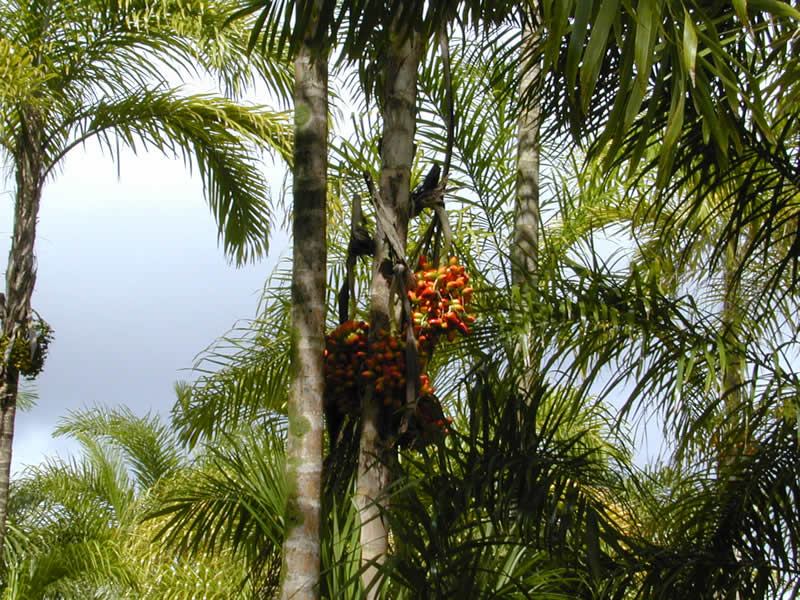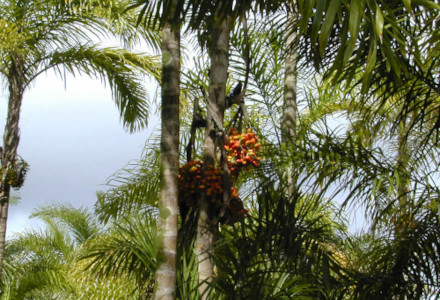
Public Domain Image
Peach Palm Facts
- Most notably, the term Peach Palm serves as the generally accepted English common name for a remarkable plant. This marvelous work of Nature also goes by the somewhat distinctive, and hard to pronounce, scientific name of the Bactris gasipaes.
- Regardless of which name someone uses to refer to it, however, the plant remains a fascinating variety of flora. This plant species also has many important uses. For one thing, it currently serves as a vital food source for many animal species.
- The Peach Palm is further used by humans for a wide variety of economic purposes. In addition to its extensive wild population, humans also often cultivate it. The fruits it produces are edible, and nutritious for humans and other creatures alike.
- Quite thankfully, this amazing tree appears to be maintaining a relatively sizable, and stable, population base. This most fortunate situation further appears to be holding true throughout the entirety of its known native range.
- The IUCN therefore currently has no listing for it on the Red List of Threatened Species. The wonder of Nature nevertheless must be considered at risk from various factors. These perils mainly consist of habitat loss and climate change.
Related Articles
English Oak Fingered Citron Bosnian Pine
Peach Palm Physical Description
The Peach Palm develops in a shape that bears a strong resemblance to related species. That’s due to the fact that this flora forms a large, but slim, vertically growing species of palm. Like most trees of its kind, the plant also typically, produces a single trunk.
On rare occasions, however, the amazing tree produces multiple trunks. In addition to this, these feature actually develop as quite small, in relation to the height of the tree. In point of fact, the trunk or trunks only average about 8 in (20 cm) in overall thickness.
These features of the tree also develop covered with comparatively stiff, black spines growing in rows. Individual specimens of this flora further attain heights of as much as 66 ft (20 m). The leaves of this marvelous variety of Angiosperm typically attain great lengths.
That’s due to the incredible fact that this remarkable foliage averages roughly 9.8 ft (3 m) in length. Perhaps more impressively, the fruit of the Peach Palm grows as either yellow, orange or red when ripe, depending on the variety. These it also produces in large clusters.
- Kingdom: Plantae
- Phylum: Angiosperms
- Class: Monocots
- Order: Arecales
- Family: Arecaceae
- Genus: Bactris
- Species: B. gasipaes
Peach Palm Distribution, Habitat, and Ecology
The Peach Palm evolved as native to a fairly broad swathe of the world. It grows naturally in scattered areas of the globe. Precisely, this zone of habitation consists of the tropical forest of portions of Central and South America. It’s also populous in the Amazon Rainforest.
This work of Nature also has specific needs for its habitat. The species thrives in areas of excellent drainage, with plenty of rainfall. Though the tree prefers lower altitudes, it also appears at altitudes of as much as 5,905 ft (1,800 m) in the Cauca region of Colombia.
To the best of the knowledge of researchers, pollination seems to be accomplished via a wide variety of insects. Local beetle species, furthermore, appear to serve as the primary pollinators of the Peach Palm. This fact alone sets it apart from related species.
Its many seeds also achieve dispersal through the actions of a variety of mammals, with birds comprising the great majority of these. Even the leaves of this tree have their uses. For human consumption, however, the fruits of the tree must be cooked for several hours.
Mankind also harvests this incredible natural resource for what remains known as its heart of palm. But, many people in its natural range still appreciate it for its usefulness as a valuable source of timber. For many reasons, it’s a vital local resource.
Species Sharing Its Range
Hooker’s Lips Hoatzin Bullet Ant
Check out our other articles on Fabulous Herbaceous Plants Named After Animals, Guinan cock-of-the-rock, Madeira, Indian Giant Squirrel, California red-sided garter snake

